Text
Silk Painting
In this blog post, I will be discussing the embellishment technique of silk painting, which was the primary focus in one of my previous workshops. Silk painting involves using a Gutta resist, which is a think paint-like substance which acts as a barrier to stop the silk paint from bleeding through. Silk paints are then used to decorate the pattern.

For my silk paintings, I decided to use a flower pattern as a base for my Gutta application, and then experimented with a variety of different colours of Gutta to produce different effects. for my first outcome, I used a black Gutta and yellow silk paint. As this was my first attempt, I opted for a more simplistic appearance and focused on achieving neatness, rather than complexity. On my second attempt, I aimed to develop my work by adding more shades of silk paint to give my sample a more realistic and dimensional appearance. This time I used a gold Gutta, which was my favourite colour out of the four I used.
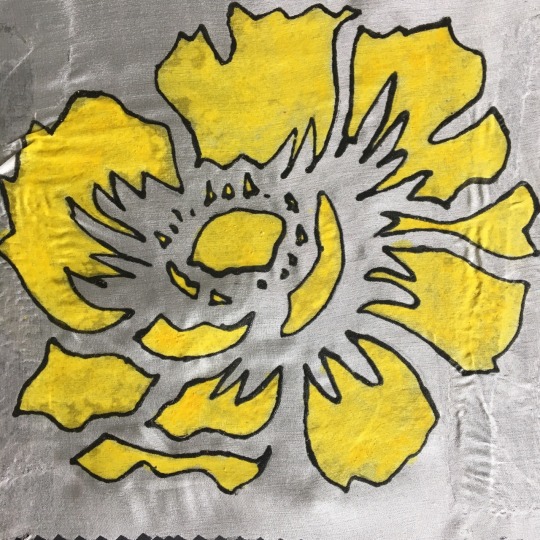

I also developed my work by applying salt to the silk paints whilst they were still wet, as this gave the paint more texture, creating a more interesting, distressed appearance. an example of this effect is shown on the image below. This was a free hand sample of two lilies I had done using a silver colour Gutta. As you can see, in areas which the salt was applied it appears slightly patchy and texture, which I believe gives the outcome a slightly more realistic appearance.

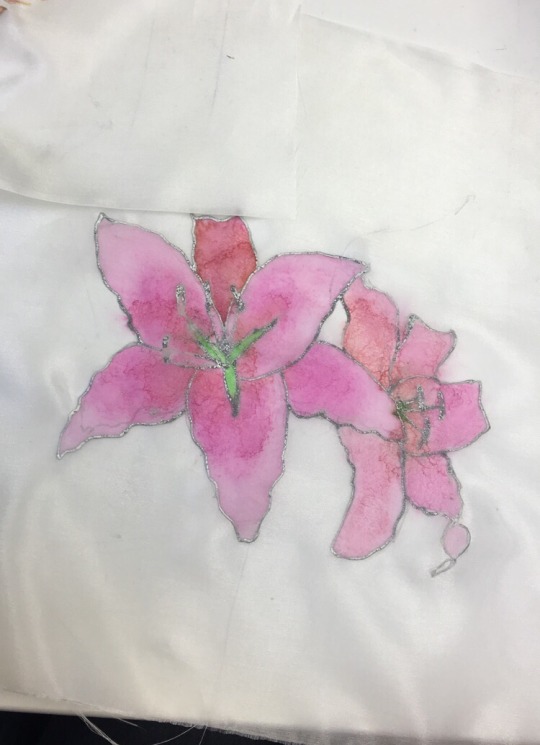
My least favourite sample is the one included below. I thought I would still include this sample into the blog, along with some tips on what I could have done to improve it, so that anyone wanting to give silk painting a try can avoid the mistakes I made and get a better result. for this sample I used a clear Gutta, which means that the resist is transparent. However, as I had drawn out my base outline in pencil, this meant that once the Gutta was applied, the pencil outline was still visible, which is something I didn't consider before starting this sample. As the Gutta was clear, it was also difficult to see whether it had been applied correctly, which meant once I was applying the silk paints, some areas were bleeding through due to not applying it well enough.

Therefore, if you are thinking of attempting silk painting, I would invest in an invisible pen to ensure that pencil markings aren't visible when you've completed the painting, especially if using a clear Gutta.
0 notes
Text
Interactive Costumes Research
In my cut and construction module, we are currently doing a live project with Bishop Auckland castle. Our brief states that we make interactive costumes for children ages 7-9 and 10-12 and each of us get out own personal character costume to produce and my character was a female Roundhead from the Stuart period. Therefore, when visiting The Fashion Museum at Bath, I got the chance to see and try on some of the interactive costumes available, and get an idea of the standard which is expected. When looking at the costumes, I paid particular attention to various factors which would help me when making my own interactive costume, these factors included the fastenings, the materials, decoration and the sizing of the costume.
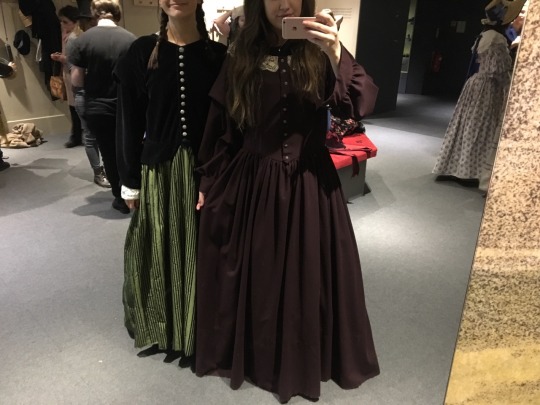
The fastenings were all predominantly tie fastenings, done to make the costume easier to try on and take off. Other than the corsets which were fastened by clips for easy application. As I am making a costume for children, I believe ties would be an acceptable fastening for my costumes. However, for safety purposes I will have to ensure that the ties are kept short to avoid any potential hazards from occurring. Another safe fastening option is Velcro, as children will be able to try on and take off the costume easily without a risk.

The interactive costumes at the fashion museum were made from various materials, materials were historically accurate to the period of the costume. However, for my costume I will be ensuring to choose a material which is unlikely to cause an allergic reaction such as cotton or linen, and will be avoiding materials such as wool as this is more likely to cause a reaction. I will also have to ensure that my fabric is strong and durable as it will be getting tried on numerous times, children are also less likely to handle the clothing gently.
The decoration on these costumes were also kept minimal, however embellishment such as buttons and trims were used. As my costumes will be worn by children, I will have to ensure that embellishment is also kept to a minimum, and trims will have to be applied well with no loose threads. I will also be avoiding the use of buttons on my costume, as they may be a choking hazard for children.
In terms of the sizing of a costume, the use of ties helped ensure that the costume was wearable for a range of sizes as you could wear it as tight or loose as needed. My costume will have to fit a 10-12 year old child, so I will have to ensure that the costume can be worn by most children this age. To do this I will ensure that I make my costume a few sizes bigger, and use either ties or elastic so that the size of the costume can be altered to the size of the wearer.
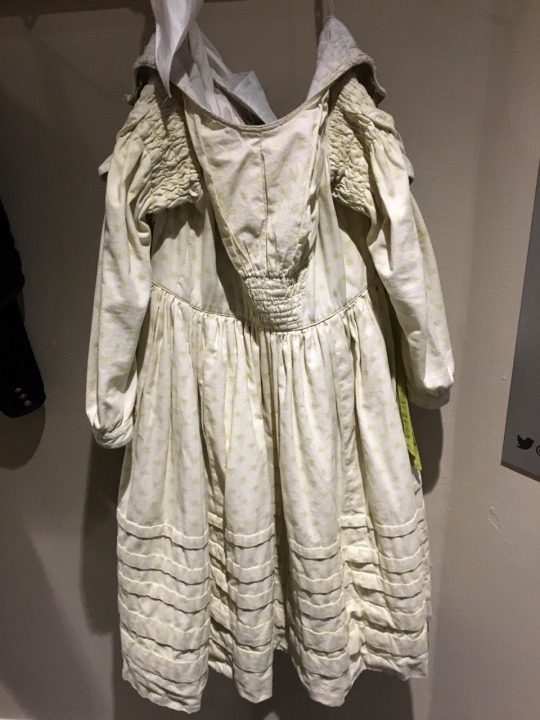

0 notes
Text
National Museum of Scotland- Textiles and Patterns

In the national museum of Scotland, I also discovered that there was an impressive collection of textiles and prints, which could be transferred into costume design. Therefore, I have decided to share some on this blog post.
The print below is called Bloody Empire, a wallpaper designed in 2013. The wallpaper was designed by Timorous Beasties and is a mix of traditional and contemporary styles. The wallpaper consists of damask pattern which has been printed digitally onto 170gsm non-woven paper and has been overlaid with hand painted bees, laurel wreaths and paint splatters for a more abstract appearance. This piece was one of my favourites out of this display as I like the combination of traditional and modern artwork.

This textile is known as Honeysuckle textile by William Morris. William Morris was a leading member of the Arts and Crafts movement and founded his own decorative arts firm called Morris & Co in 1861, which predominantly inspired interior design during the Victorian era. The textile print was made from Tusser silk and is block printed.

Below is an example of post war textile design, called Herb Antony, designed by Lucienne Day and made by Heal fabrics. Once the war was over, there was a sudden increase in textile mass production and ideas. Lucienne Day was one of the prominent women designers involved in this textile design movement, as well as Marian Mahler. Designed were often abstract and influenced by forms of nature and science.

This is an example of a tapestry seat cover from 1948. The seat cover is made from wool and cotton and was woven by the Edinburgh Tapestry Company. However, it was designed by artist Cecil Beaton. Although this is a seat cover, the floral embroidery could be transferred and used on a costume.
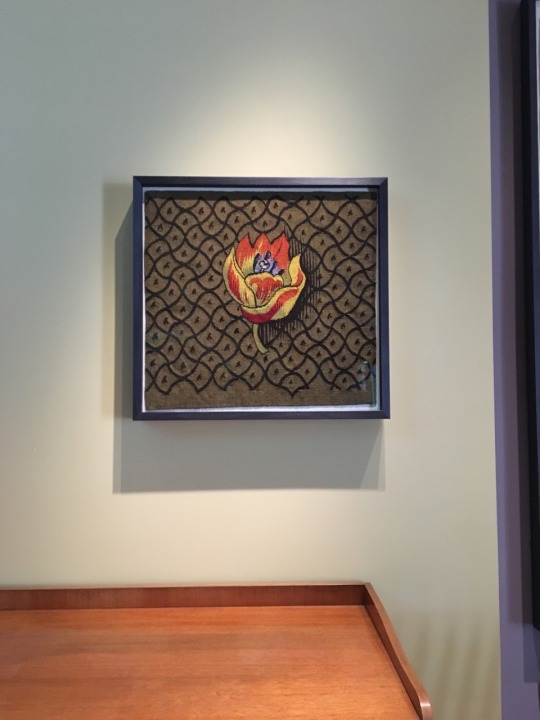
Below is three panels all together known as the Red Crosse Knight dated from the 20th century. The Red Cross Knight is a character in the 1590 poem, The Faerie Queene, and became popular again in the 19th century due to an obsession with chivalry. The artist Phoebe Anna Traquair was then influence by the poem and produced these embroidered panels. On the left there is The Red Crosse Knight riding with Princess Una, middle in The Red Cross Knight slaying the dragon whilst Princess Uno is praying and on the right depicts The Red Crosse Knight being kissed by Princess Una. I also decided to take a close up photograph of the detail involved in the embroidery.
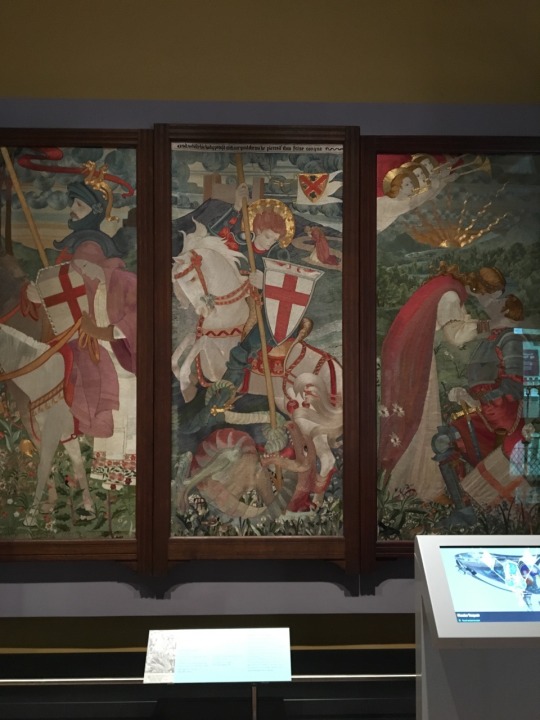

This embroidered hanging was made by Theodosia Middlemore and May Morris, the daughter of William Morris. The hanging is dated between 1900 and 1910, and designed by May Morris in 1891. It is made from linen, and wool from Orkney. Below I have also included an image of an embroidered design of doves, roses and clematis from 1900. It was designed and embroidered with silk threads by Margaret Hamilton.
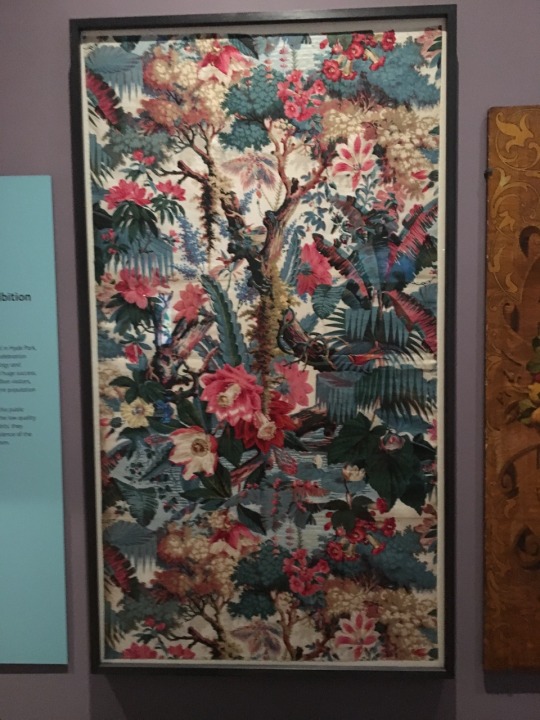

0 notes
Text
National Museum of Scotland- Part 2
In this blog post, I have decided to include some more images from the National Museum of Scotland, as it was difficult for me to narrow down my favourites. Therefore, below is an image of a presumably mink fur coat from 1920. The bottom half of the coat is also made up of silk brocade and has a floral metallic embroidery. In the 1920′s and 30′s, fur was a peak trend and it was common to see fur used for either an entire coat or just the trim. Common fur types used were sable, ermine, mink and fox, all of which were the most expensive.
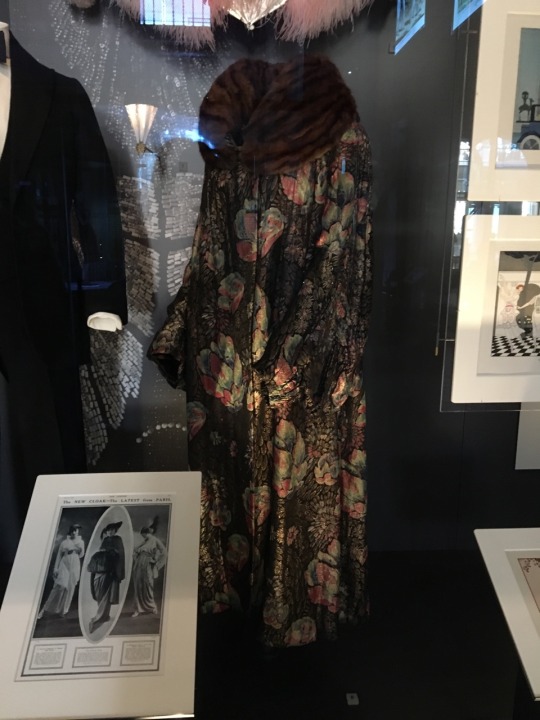
This evening cloak made in 1912 by Redfern, which was a British-founded couture house. The cloak is made from broadcloth, satin and satin covered cord. The brand was known for making tailored clothing fashionable and acceptable for women. The shoes on the bottom right hand corner are from 1910. They are made from satin and embroidered with glass beads.

The evening dress and matching jacket is from 1930 and is made by Elsa Schiaparelli. Pleated sleeves are a Common attributes of a Schiaparelli clothing and the buttons are also a distinctive attribute within her designs. Both the dress and jacket are made from rayon crepe.
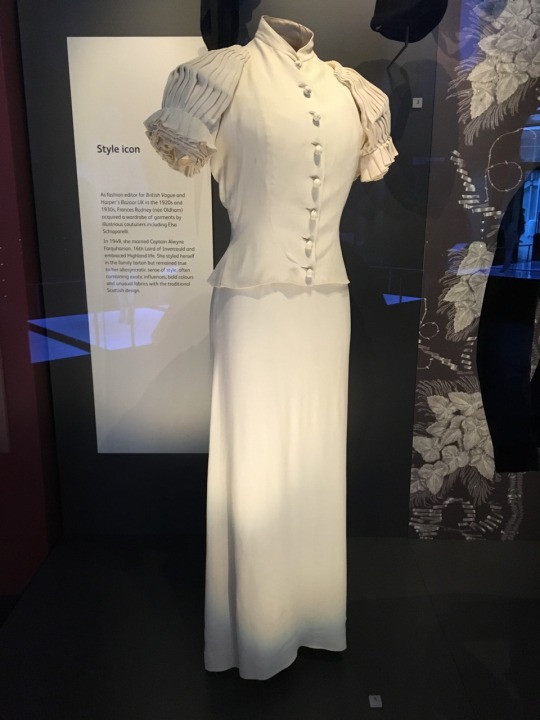
Below is a tunic and trousers from 1971 by Givenchy. Givenchy took inspiration from the oriental style clothing trend in 1960, as well as the Turkish ‘shalwar’ and ‘entari’.

This is an example of a children’s outfit from 1760, and is believed to have belonged to Thomas Hamilton of Haddington. The suit is made from silk velvet and cotton. In the 18th century upper class children’s clothing was a representation of their parents clothing and boys and girls were dressed similarly. Petticoats were a common clothing item for both boys and girls until boys were old enough to wear breeches. When health and safety became more important, clothing became more loosely fitting and simplistic.

This is a Sacque dress from 1740, and is made from silk and embroidered with metallic thread. This dress was originally a negligee gown and then became more formal and acceptable for women to wear.
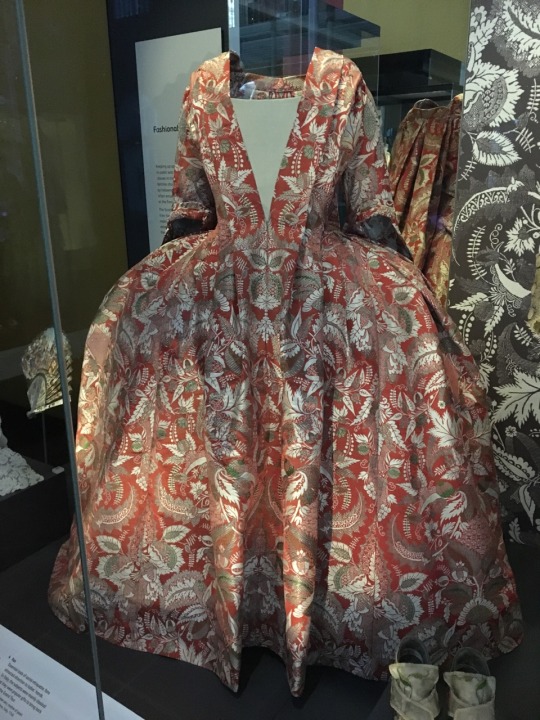
Evening dress by Lucile Ltd, made in 1918. Made from silk and embroidered with gold net, satin binding and silk flowers.

Bodice and skirt from 1900, made from organza, silk chiffon and machine made lace. This garment was made my Worth and clothing by this company was often tailored made to fit the individual’s specifications.

0 notes
Text
The National Museum of Scotland
This weekend I went Edinburgh to see some of the sights it had to offer. Whilst I was there, I decided to visit the national museum of Scotland as I had heard that it had an impressive fashion section, and I thought it would be beneficial for my current studies. Although I took many photographs of the various costume displays, I have only included some of my favourite items, which relates most to my study.
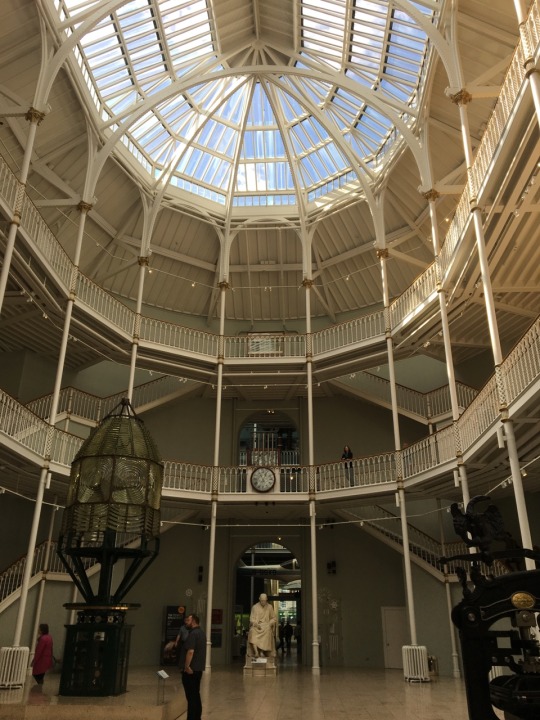
The dress below is dated around 1885-1888 and was made by Gowan and Strachan. The dress is made from silk velvet, cotton and steel for the bustle. The dress has a tight fitting body and a large bustle protruding from behind the dress. The shape of this particular dress is often exaggerated in fashion plates, however, they were not as large as made out to be. It is also uncommon for a dress to be made out of silk velvet during this period as this would have been an extremely heavy fabric to carry. Below is also an example of a Crinolette from 1870, this would be worn underneath a dress in order to alter the silhouette. The Crinolette was the transition from a cage crinoline to a bustle. The pads were usually stuffed with horse hair to add volume and structured out of metal or cane.


On the other hand, the dress below is an example of a bodice and crinoline skirt from 1860, made from silk and cotton. Crinolines were used to replace heavy petticoats which would often be layered to create large amounts of volume. The structure of the crinoline was made of sprung steel hoops. Often the crinoline would be so large that women would struggle to fit in to carriages.

Below is a day dress from 1830 made from cotton. It was a common trend during this era for sleeves to be extravagant and puffed, along with voluminous skirts and constricted waist. It was also common to have a low, wide neckline, however, for modesty the dressed were often worn with a matching shoulder cape.

The dress shown below is a court mantua from 1750. The gown was made form silk, gilt metal and linen. The gown was worn to reflect the wearer’s status, meaning that they were often heavily embroidered in gold or silver thread or gilt lace. This particular gown was believed to have belonged to the Countess of Haddington. I have also included an image of a hoop petticoat and stomacher below, both from the 1700’s. Stomachers were worn to achieve a small waist, whilst the petticoat was used to create large amounts of volume in the skirt. During this period it was also common for skirts to be very wide yet flat at the front and back.
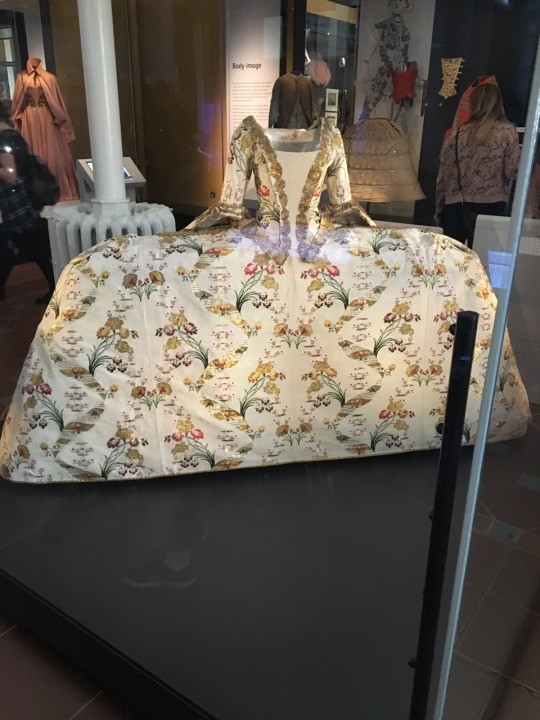
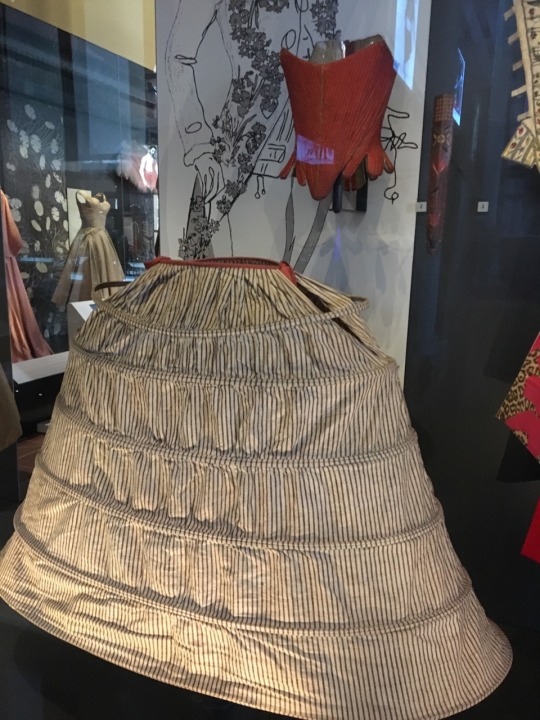
This evening dress was made by Ceil Chapman in 1950, and is made from taffeta cotton. Chapman was a well-known Hollywood maker in the 40’s and 50s and had also designed dressed for Marilyn Monroe.

The dress below is a ball gown made by Jacques Fath in 1948. This gown is made from silk satin and is embroidered with sequin. Fath is a designer which contributed to the rebirth of couture after the WW2.
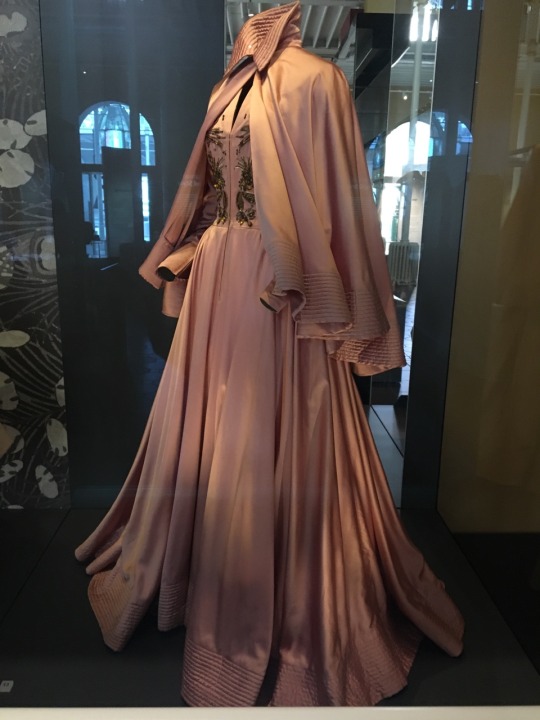
0 notes
Text
Alexander McQueen
Alexander McQueen was a British fashion designer and courtier and is especially famous for his bold, structural designs. In each of his outcomes he used exaggerated amounts of materials to create larger amounts of texture within each outcome. The inspiration for many of his garments comes from nineteenth century ‘haute couture’ and other historical centuries, in terms of wide, bold shoulders, combined with a nipped waist and exaggerated curves, replicating the fashion trends of the nineteenth centuries. As well as this, his creative influence is also inspired by the the natural world.

In his work, he also aims to reflect paradoxical affiliations often his work appears to be dark, when actually, he is often aiming to represent the contradicting theme to that. For example, he would use a melancholy theme in order to represent the opposing theme of beauty. In his designs he pushes the boundaries of fashion by creating abstract pieces of ‘wearable art’, creating a new outlook on what is considered to be beautiful and acceptable in clothing.
An example of an Alexander McQueen dress is the one shown below, known as the ‘Sarabande Dress’. This dress was inspired by nineteenth century Haute Couture, which is reflected in his use of wide shoulders and small constricted waist. In his work he also likes to experiment with proportion, which can be seen in the exaggerated, structured shoulders in the image below. The dress is made from silk satin, silk lace and organza, and has been embroidered in sequins and beads to give the garment a feminine, elegant appearance.
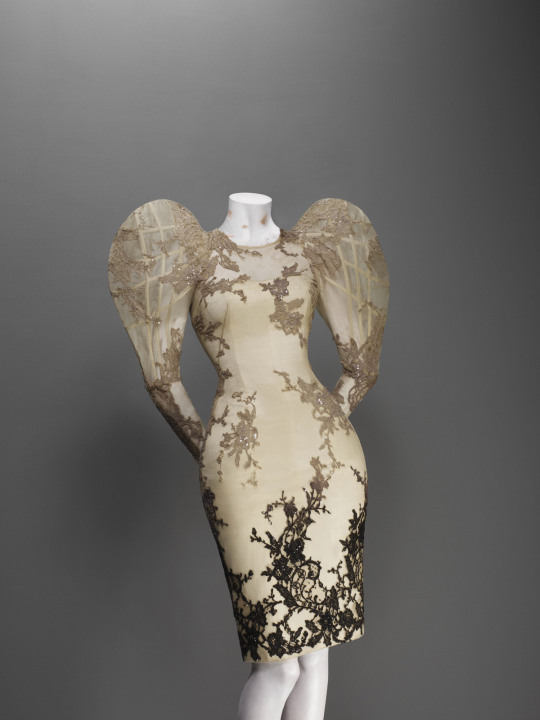
0 notes
Text
Embroidery Workshop

In one of my recent workshops, we have been looking at the embellishment technique, embroidery, Therefore, I thought I would focus a blog post on this subject, as I found practising this technique enjoyable.
Initially, I looked on websites such as Pinterest for some embroidery inspiration to influence my designs.As well as this, I also attempted to search for some techniques within this embellishment form so that I could experiment further in the future and achieve a range of different outcomes. In the end, I decided to go with a large flower design as the outline for my embroidery, to ensure that I had plenty of room to practise and develop my skills.
As I went for a flower for my design, I decided to use red and purple embroidery thread for a more realistic appearance. I also decided to used a darker red shade on the outline to create a shadow effect. When I first began, I was a little hesitant and found it difficult to control my movements, when led to the stitching appearing slightly messy. However, after a few minutes I picked up the technique well and was able to make my outline appear neat. Once I had completed the outline of my sample, I then decided embroider a full petal in order to develop my work further.
I aim to develop my skills in embroidery and practise this technique further, I also aim to experiment in the technique applique to see what outcomes I can produce.

0 notes
Text
Its a Wonderful Life
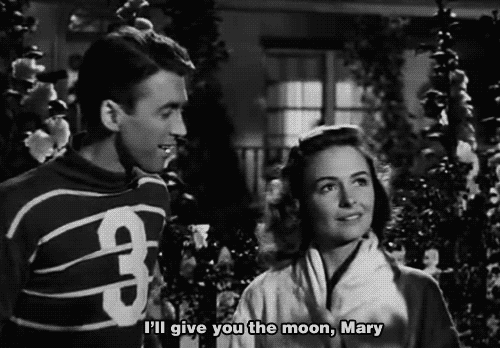
One of my favourite films to watch lately has been ‘Its a Wonderful Life’, produced by Frank Capra. The film was released in 1947, however the film is supposedly set in the 1920′s. The film is based on a man who receives guidance from his guardian angel whilst he is experiencing a tough time. The angel then shows him what his life would be like if he had never existed, which results in him beginning to appreciate what he has. Therefore, in this blog post, I will be discussing some of my favourite costumes worn in the film and reasons why I believe that the styles were chosen.

The video above is from the scene which Mary and George meet in adulthood, and share a dance. Mary is wearing a frilly knee length dress which would have been a common style of dress worn to dancing events in the 1940s. Although this film is set in the 1920s, during this era it was more important to costume designers to produce an appealing dress rather than an historically accurate one.Therefore, it is common to see costumes used which would have been more appropriate for the time is was made rather than the time the film is set in. In a revamp of the film the dress has been made in a blue colour, however in my opinion, I believed that this dress would of been a pink colour to match her innocent personality.

Above is an image from one of the most famous scenes in the film. George is seen wearing a typical 40s style, 3 piece suit, made up from a shirt, necktie, waistcoat, single breast jacket and single pleat trousers. This style of suit could of been used to indicate that George dresses as man he aims to be, as a 3 piece suit was typically worn by more upper class society and George is more lower/middle class. On the other hand, Mary is wearing a long silk dress which appears elegant and feminine in order to represent her graceful personality, it also believed to be a dusky pink shade. The dress also consists of dainty floral embroidery around the V neckline and hem, and the wide puff shoulders are also a good indication of the era the film was made in, as this was a common attribute of women's clothing during this time.

In the scene shown above, Violet is complimented on her outfit, ‘to which she replies ‘oh, this old thing? Why, I only wear it when I don't care how I look’. This indicates that Violet is attempting to appear as if she is effortlessly attractive and well put together, when she has actually put in a lot of effort to look beautiful in an attempt to impress George. Violet is known as the most glamerous in the film and is well known for her flirty personality. Her outfits are always fashionable and on trend, and she is almost always seen wearing a hat or a hair piece. In this scene she is seen wearing a short, floral patterned day dress with puffed sleeved, I believe this was chosen in order to express her flirty, feminine personality as there is a lot of skin on show.
0 notes
Text
Roman Baths- Research

This blog post will be focusing on the photographs I have taken on my visit to the Roman Baths, whilst on a trip with my university class. I decided to write about these images as research for future reference, as it may be beneficial information for future uni modules.
The roman baths is one of the best preserved Roman remains, and was constructed in around 70 AD. Over a million litres of water, 46°C, still fills the baths every day, which has now a green colour as it had been affected by algae due to sunlight. Originally, the baths would of been covered by a 20m high roof. The baths were built three natural hot springs, and there was three different baths constructed. The cold bath, named the Frigidarium, the warm bath called the Tepidarium and a hot bath, also known as the Caldarium. As well as the famous pools, the baths also has heated rooms, modernly known as saunas. The saunas were constructed above stacks of stone which allowed hot air to heat the floors and walls.
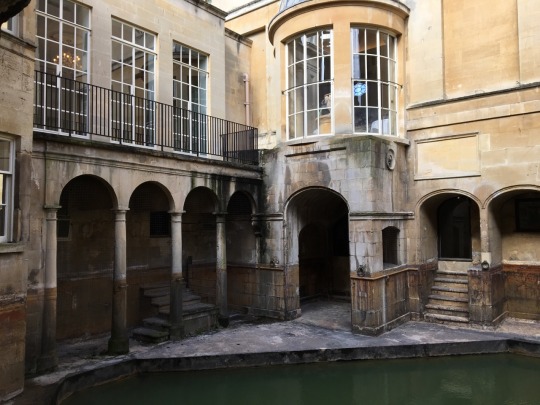
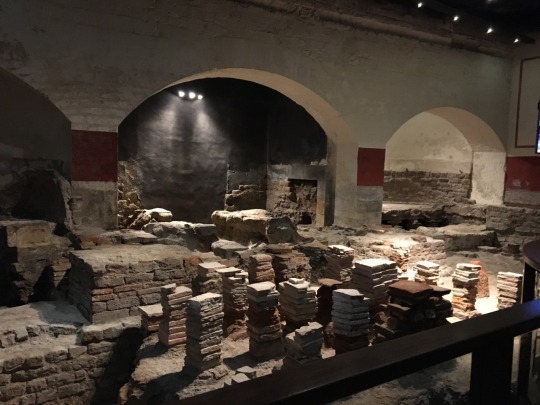

0 notes
Text
Bath Fashion Museum- Royal Women Display
Currently, the Fashion museum in Bath has a display dedicated to the clothing worn by some of the women in royal family. Therefore, I thought it would be an interesting subject to blog about and may be beneficial for future modules.


The dresses shown above were worn by Princess Alexandra. Princess Alexandra married Queen Victoria’s son, Prince Albert Edward in 1863. The first image of the white gown was the wedding dress worn by the Princess, initially Queen Victoria insisted that the princess would wear lace for her wedding day, however, Alexandra opposed of this decision and instead when for a more slender silhouette. The dress also did not contain a cage crinoline which was a common attribute of gowns at the the time. It is believed that Alexandra preferred more simplistic, elegant designs which is reflected in the second image of the lilac silk evening gown from 1893.
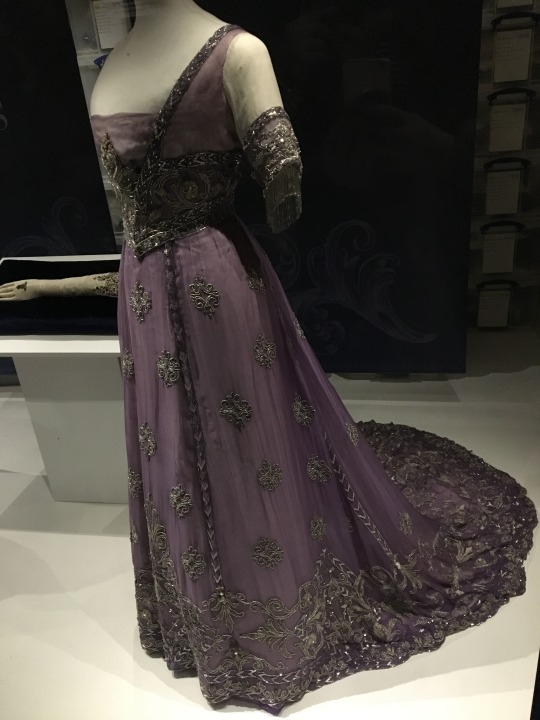
The two dressed shown below were worn by Queen Elizabeth and both dresses were designed by Norman Hartline. the dresses are both heavily embellished and have a similar silhouette achieved by the large crinoline style skirts and nipped waist.
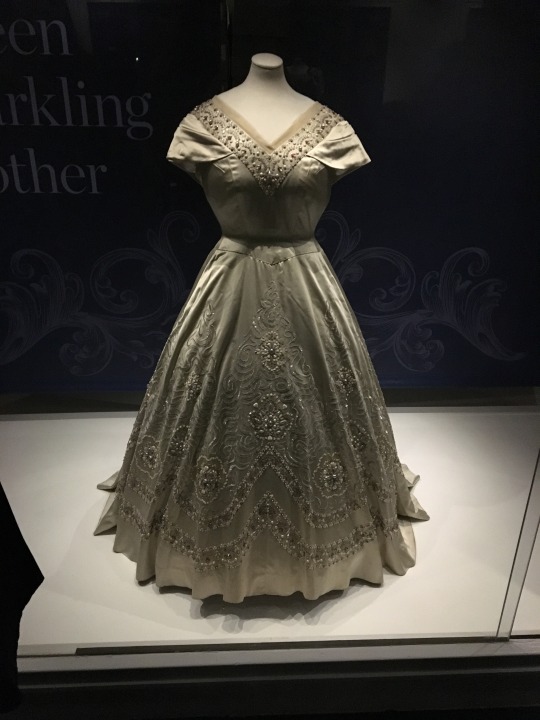

0 notes
Text
Green Giant Costume
Recently, I had the task of creating a Green Giant costume for a fancy dress event. To get an idea of what the costume consisted of, I had to conduct research on the typical outfit worn by the green giant and also looked at other people’s interpretations of the costume on Pinterest to gain some inspiration. From looking at the particular image of a tin of green giant sweetcorn (shown below) I could see that the costume consists of a green tunic decorated with leaves.
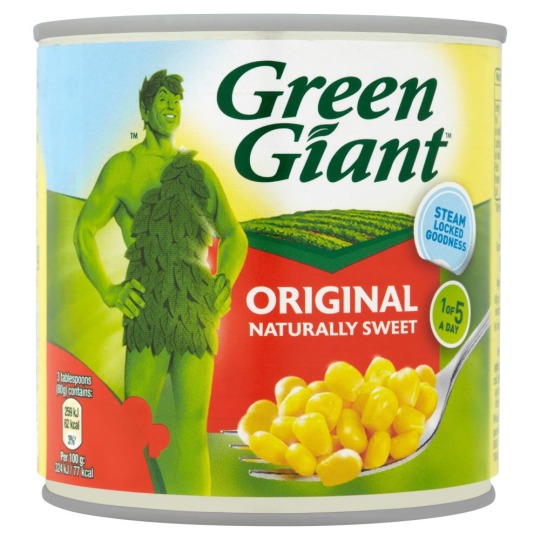
Therefore, I began by buying an XXL green T-shirt, as the man I was designing it for is 6 ft 8 inches tall, so I had to ensure that the T- shirt was long enough to resemble a tunic. I then cut from the neckline to the bottom of one of the sleeves, replicating the shape of the costume worn by the green giant. Once the initial shape of the tunic was complete, I then moved on to the decoration. To do this I bought an assortment of artificial leaves, and then hand sewed each individual leaf onto the costume. For the event, the costume was paired with green tights and green face/body paint to complete the recreation.

In my opinion, I believe that the costume was successful, although I was only given a short timescale to complete it within. A reason for this being that the costume looked realistic and replicated the original characters costume well. Also, as the costume decoration was predominantly hand sewn, this ensured that the costume was durable and lasted well throughout the night without being damaged. I also found it enjoyable having to be resourceful with my materials.
0 notes
Text
Bath Fashion Museum
During my visit to Bath, I went into the Bath Fashion Museum to gain some insight into various fashion styles over the years and how fashion has changed. Below I have included some photographs taken of the some of the displays which I found interesting.


The dress shown above on the left is a woven silk open robe from 1730, which was worn for formal occasions.The robe was usually worn with a silk petticoat, often in the same fabric and print of the dress. Large floral patterns were also a common trend during the 1730′s. On the other hand, the dress on the right is a brocade, woven silk closed robe from 1740, which means that it didn't have to be worn with a petticoat.

The mans waistcoat from 1740, is made from silk and embroidered with silk threads in a symmetrical design. This kind of waistcoat would typically be worn with breeches and a coat.
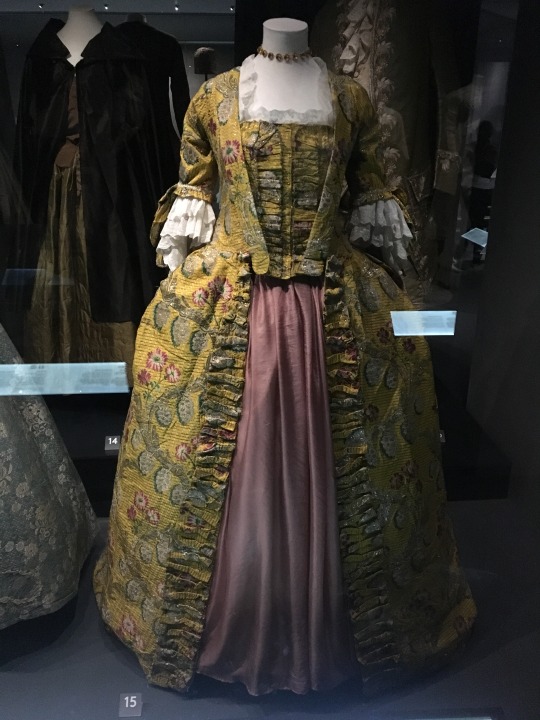
This dress is called ‘Robe a la Francaise’, from the period 1760. The dress is made from silk and is sewn with metal thread in order to give the robe a glittery effect, portraying the wearers wealth. The dress originated in France as a loose gown, however, with the application of extravagant ruffles and pleats, the gown became more appropriate for formal occasions. Fashion during this time, was influenced by the mistress of Louis XV, Madame de Pompadour, which may have helped influence the design of this gown.

Above shows a white wedding dress from 1840. The dress is made from woven silk with a lace embroidered silk net and trimming on both the dress and veil. The trend of wearing white to a wedding has been around since the 1800′s, however, once Queen Victoria wore a white dress to her own wedding, the trend became more accepted. Queen Victoria's dress was also made from silk with lace details and trims.

This 1860 day dress is made from lightweight, printed cotton and is made up of a separate bodice and skirt. The voluminous skirt was achieved by wearing a cage crinoline, structured by hoops of steel, which means that women no longer had to wear numerous layers of petticoats to achieve volume.
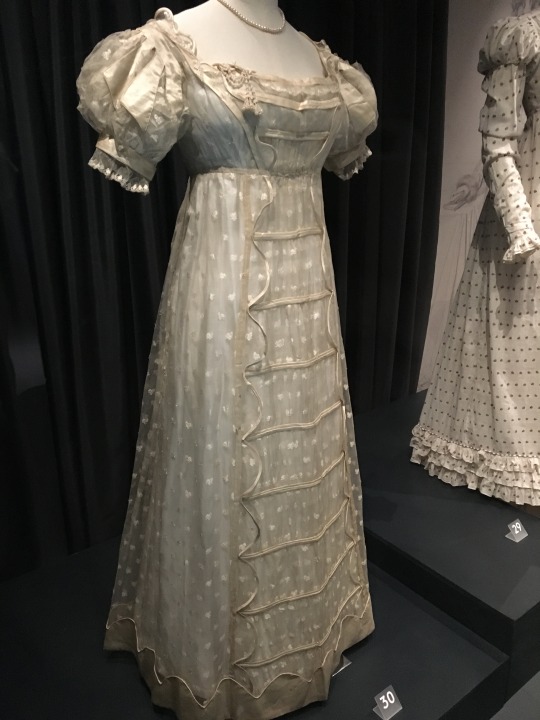
The dress shown above was made in 1817 and made completely of silk gauze, also known as madras lace, even the details were made from silk. This is because, in this era, dresses made entirely from lace were very fashionable and on trend.
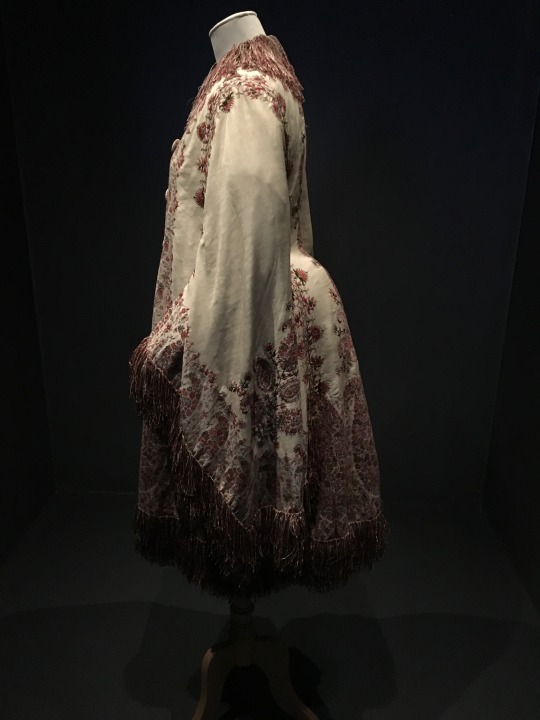
The attire shown above is a Dolman from 1870, which at the time was a new style of outdoor attire. The Dolman is part coat/cape, typically worn by men and was worn draped over dresses. They were commonly made out of woven cashmere.

This dress is a beaded evening dress from 1958, produced by couturier Norman Hartnell. The dress is made out of synthetic silk fabric and crystal beads, in order to promote the use of man-made synthetics in fashion.
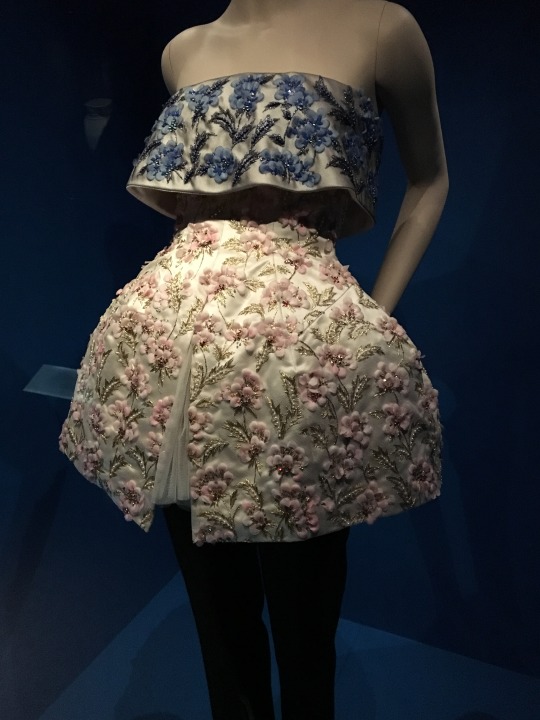

The short evening dress shown above was made by House of Dior in 2012 and was chosen as dress of the year the same year. The dress is also displayed worn over cigarette trousers.
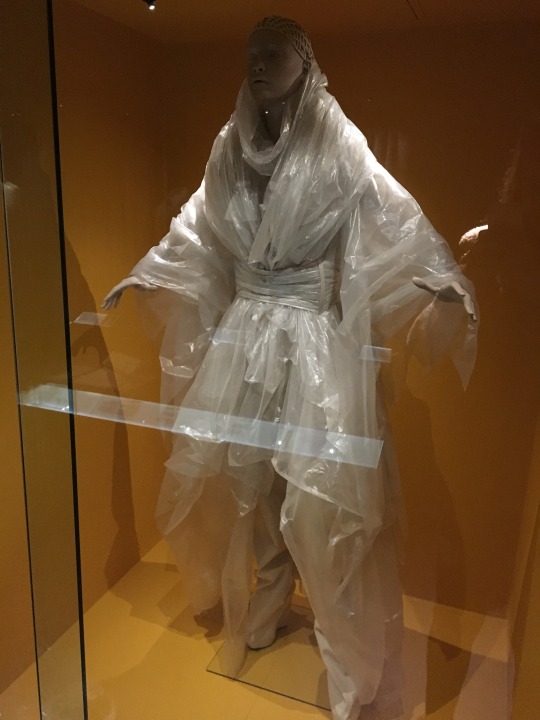
4 notes
·
View notes
Text
Bath, Somerset

Recently I went on a trip with my university class to Bath, Somerset, to see some of the historical sights and museums to gain inspiration for my study. The town of Bath is situated in the Southwest of England in the countryside, and is well known for its historical land marks and distinct Georgian architecture style. Baths 18th century architecture is unique due to its pale coloured, bath stone, which was specifically used for the construction of the buildings in Bath. Although this blog post is not specifically focused on costume, I believe that architecture can be used as inspiration for costume in terms of the structure and attributes of a building.
An example of a designer who has used architecture as influence is Chloe. who in the example below, has taken influence from the details used in the arabesque architecture and portrayed this within her design with the use of lace and repeating motifs.

Below is an example of the honey coloured, Georgian bath stone used for the towns architecture. The street shown is a street called Royal Crescent, which consists of 30 houses and is 150 m long. The appearance of the houses are relatively the same with minor difference as some have small balconies, however all houses have slate roofs and large columns. The street was built in 1774 by the architect John Wood. In terms of costume, this could provide influence for a gown as the pale colour scheme could be transferred into a costume. As well as this, the symmetrical appearance and vertical columns could be used as influence for a dress.


Another landmark I visited was Bath Abbey, which is commonly recognised by its Gothic style architecture, large stained-glass windows and its fan vaulted ceilings. Bath Abbey is an Anglican Parish Church and was founded in the 7th century and rebuilt in the 12th and 16th century. The building is situated near the famous Roman Baths which is where the image below was taken from. Bath Abbey could be used as influence as believe this particular architecture would inspire a Gothic themed dress.
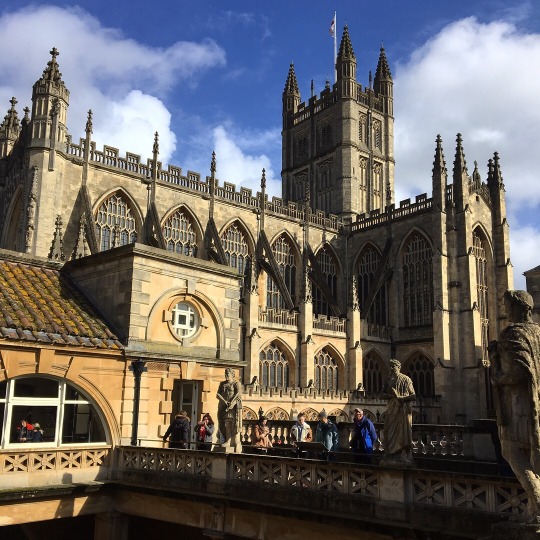
0 notes
Text
Leeds Armoury Embellishment
In this blog post, I will be discussing some of the various embellishment techniques used on some of the armour displayed in Leeds Armoury. It was interesting to see the vast amount of embellishment done on the armour, as it was something that I never expected to see on clothing primarily worn into battle. In the images shown below, shows some of the various embellishment techniques used on armour from the medieval period.
in the first two images, there is a visible beaded pattern been applied to the armour. For example, in the first image, the embellishment has been arranged in a floral pattern, whereas in the second image, the embellishment has a more geometric pattern. On the sleeve shown on the bottom left of the first image, there is also embellishment techniques, the raised pattern could of been produced by Trapunto quilting or Cording.


On the other hand, i believe the embellishment shown on the two image below has been produced using a similar technique, as the result is similar in appearance. This technique appears to have been produced from threading a piece of fabric through holes in the armour, in order to form a repetitive pattern.

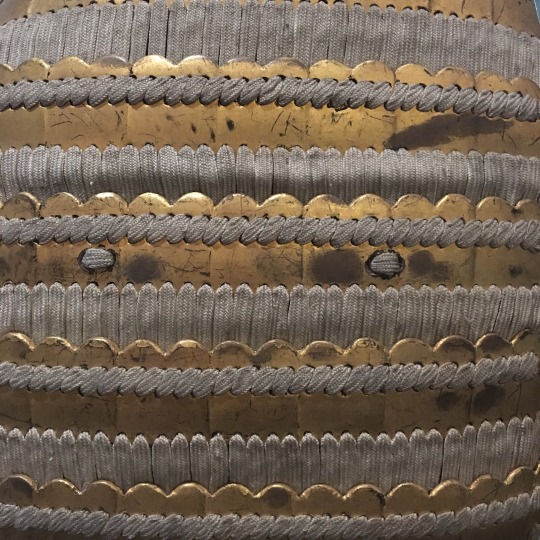
I have also decided to include some images of fabric and pattern samples displayed in the museum to give some insight on what kind of fabrics and materials where used in medieval costumes. These particular fabrics samples where displayed in the section on Japanese armour and weaponry. I have also decided to include this as aspects of my current Embellishment module focuses on Japanese embellishment, so these particular images may be beneficial to my study.


2 notes
·
View notes
Text
Leeds Armoury

On an education visit, I visited Leeds Armoury with my Uni class to gain inspiration and knowledge on historical armoury, as this is the subject one of my modules is based on the Medieval/ Stuart period. As my personal assignment focuses on the Stuart era, specifically Stuart women, I didn't find this visit as inspiring as I would of liked, as the museum displays were predominately based around Medieval male armoury. However, I still found the armoury displays interesting and the knowledge learnt from this trip may be useful for future projects.
Although I wasn't able to gain much inspiration from this trip for my Cut and Construction module, I still found the museum an enjoyable experience and it was interesting to see the various types of historical armoury. On the other hand, I was able to gain some inspiration for my Embellishment module as there was various elements of embellishment shown on the costumes. Therefore, I have decided to base my next blog post on the various embellishment techniques shown on the costumes. Below I have included some images taken from my visit.
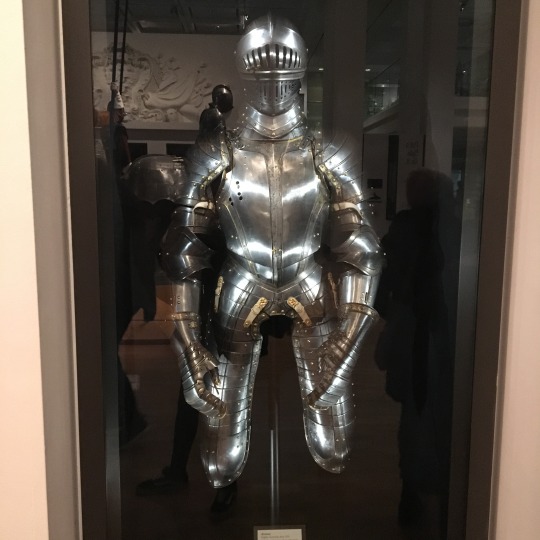

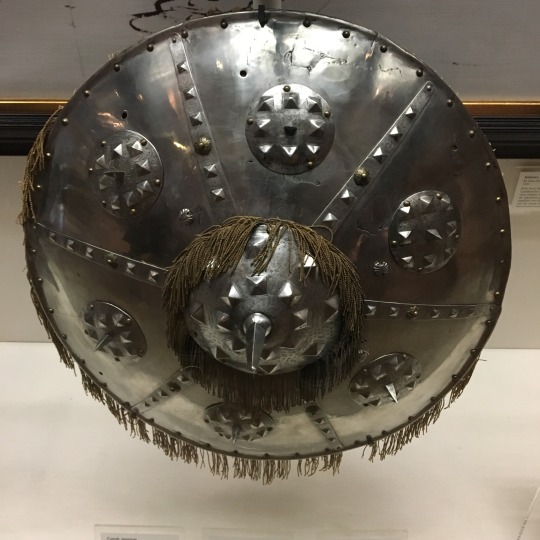



0 notes
Text
Dark- Netflix series

In my free time I enjoy watching a variety of films and TV series, and paying particular attention to the costumes used, also helps me to gain more knowledge and understanding aiding my study. Therefore, I have decided to dedicate this blog post to my most recent series favourites, and discuss why the choice of costume is appropriate to the particular film or show.
Dark (Netflix series)
The Netflix series, Dark, is my most recent watch and this is a thriller/mystery drama, with elements of time travel throughout. As the series is based on time travel, it’s important for the costumes worn to be accurate in order to represent the era which it is set in at the time. The series is set in Germany and primarily focuses on the years 1950, 1980 and 2018 .
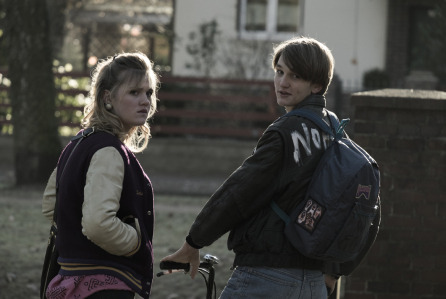
The image shown above is set in the Germany 1980. The male costume is based around 1970’s/ 80s punk style in terms of the leather bomber jacket with the statement word ‘no fear’ printed on the back. This aspect of the costume in particular also helps to portray the characters rebellious teenage nature. The character is also wearing jeans, possibly Levi’s’ which were popular during this particular period. On the other hand, the female character is shown wearing a varsity jacket, suggesting the characters age as well as a pink feminine t shirt underneath. I think that the costumes worn, portray both the era and the characters personality's well, as the male is successfully portrayed as the rebellious teenager, whereas the female is depicted as the popular, well-liked school girl.

On the other hand, this image above is from a scene set in the 1950′s. the woman in the image is seen wearing a black stylish hat. Sun hats were a common accessory worn in this era as they were very versatile and came in a variety of colours to match every outfit. The woman is also shown wearing a red, pencil dress with matching fabric belt in order to achieve the nipped waist appearance, common in Christian Dior's ‘New Look’ collection. The colour red also relates to the period as a patriotic colour scheme was a popular choice during the 40′s/50′s in relation to the war. This costume helps to represent the characters personality as she appears to be a classy and wealthy women. The colour red could have been used to represent lust, as many of the male characters are attracted to her feminine personality, as well as strength, as the character is an independent women, which is uncommon during this time period.
0 notes
Text
Embellishment
For my most recent design module, we have been focusing on embellishment and the various symbolism contained within the techniques and patterns. Therefore, for our initial workshop we looked into the stencilling technique.
Below I have contained image examples of some of the samples which I produced during the workshop. I decided to use both wax card and acetate paper stencils as resists. To produce these samples I used a variety of different mediums such as fabric paint and oasis spray, as well as materials such as sponges and paintbrushes to apply the products on to the sample. I also decided to use lace fabric samples as resists in order to experiment with adding texture to my samples. To experiment further, I also used different fabrics for my samples to discover the various effects that could be created by using different materials. Overall, I found this workshop an enjoyable experience as I found the technique simple to do, yet effective. I also think this style of embellishment will be useful for me to demonstrate in future projects.


3 notes
·
View notes